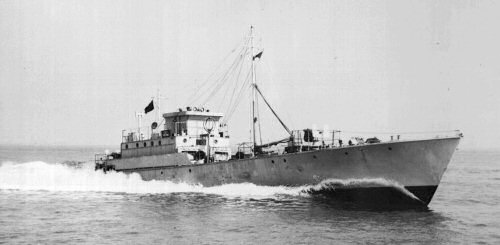South of Cambodia Point November 8, 1942
HMS Ashanti, Eskimo, Tartar, and Nubian advanced slowly in the night. Low clouds hindered visual searches but the rotating radar antennas probed the seas with their electronic shouts. As they reached the northwestern edge of the patrol box, they turned to the northeast, given wide berth to a recently reseeded minefield. Look-outs strained their eyes looking for mines and looking for targets.
Aboard the divisional flagship, a short conference was held by the force commander and his trusted flag captain. They had been together for almost a year now and their successes had built upon each other’s trusted competence. A radar operator swore he had good contacts off in the distance 27,000 yards away through the murky night. Soon, the light shutters clanged open and shut as the destroyers increased speed, cleared the decks and changed course slightly.
Eleven minutes later, three out of the four large destroyers had firm radar contacts at 17,000 yards. A modest coastal convoy of three or four merchant ships and a pair of destroyers were showing up on the scope. Soon, the four large destroyers accelerated to combat speeds. They were arrayed in a single line and had cut across the convoy’s path as the range fell to under 8,000 yards. Every gun was tracking on a target. Each destroyer picked its own target, the flagship and her first consort were focused on the Japanese destroyers while the last two ships were already getting ready to slash into the merchantmen.
Sixteen torpedoes entered the water. By now, the radars were honing on their targets and the gun mounts made the slightest adjustments as the line of destroyers had begun to curl around the port flank of the convoy. The range continued to close as the torpedoes spread out through the water. Finally as the four destroyers were closing to within 6,000 yards of the lead escort, surprise was lost as a searchlight snapped open and a white beam poked at the sea in the general area of Nubian.
Before the light could provide a target for the two Japanese escorts, the Royal Navy announced themselves as twenty four guns started to fire. The first minute of rapid fire produced no devastating hits although the gunnery was good as near misses and straddles sent shrapnel up and down the decks of the Japanese ships whose crews were scrambling for action stations. Eskimo then scored a trio of hits whose value was rendered worthless when her target’s back broke from a torpedo detonating yards from her forward magazine. She shifted fire to the sole surviving escort and soon, Yudachi was being smothered by a squall of shells. First her forward twin turret went silent after shells from Nubian demolished the gun house and then her bridge was set afire. Her aft turret scored a few hits against Tartar with little effect.
Ashanti twisted and turned in the water to dodge a wave of torpedoes fired in her general direction even as her guns set first one and then a second coaster on fire. An hour later, the convoy had been destroyed and the four destroyers turned south and headed for air cover at twenty eight knots.
